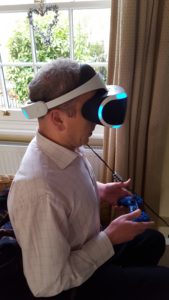I crashed a plane three times today. The first time I crashed into a tree, the second time into a river, and the third time into a bridge.
But it is all okay as it only happened on my son’s virtual reality console. I think that I learned a bit—as I managed to stay airborne for a whole 30 seconds on the final flight. A few years ago, flight simulators were only available in dedicated centres and you had to book a session in advance to use them. Today all you need is some simple kit. As shown on this photo:

Tomorrow it will probably all come with your phone.
Will simulation in healthcare professional education go in the same direction? Simulation offers many advantages to the medical learner. You can practise your skills in a safe environment—without harming patients and without affecting your self-confidence. You can learn in a team—ideally as part of an interdisciplinary team. You can learn clinical and communication skills and learn to integrate those skills. You can practise rare but potentially catastrophic events—such as cardiac arrest in a young person.
There is only one problem—you can’t do it when and where you would like to, or as often as you might need to. There are many more simulation centres than there were twenty years ago—but you still usually have to book a time slot to use them, and they are normally only available during working hours.
But the advent of virtual reality means that simulation in healthcare professional education may be coming to your office or your ward or your home—and sooner than you think. It will offer many of the same advantages that come with face to face simulation. As with all new technologies it will be expensive initially, but then costs will fall. But its real advantage will be its convenience—you will be able to practice as and when you like and as much as you like. You will also be able to form communities online and practice with colleagues in virtual teams. Of course, there will be downsides—the main one being that virtual reality is virtual and not quite as real as the real world. So as with all innovations, virtual reality will find its place in the curriculum and will not take over the curriculum.
But it’s worth asking where exactly will it fit in the curriculum? Specifically, is virtual reality e-learning or is it simulation?
E-learning and simulation have grown up separately over the past two decades, but it is probable that virtual reality will bring them together. Our very own BMJ Learning is an e-learning resource but we have seen the pattern of its usage change recently—with the growing popularity of its more multimedia and interactive resources. The bar to creating such resources has fallen over the years and this will continue. As providers move to meet learner needs, it is likely that it will be the learners who will decide how we will learn in the future. But we shouldn’t spend too much time asking ourselves what the future will look like: we can just look at what our children are doing now.
Kieran Walsh is clinical director of BMJ Learning and BMJ Best Practice. He is responsible for the editorial quality of both products. He has worked in the past as a hospital doctor—specialising in care of the elderly medicine and neurology.
Competing interests: Kieran Walsh works for BMJ which produces resources in clinical decision support and medical education.
